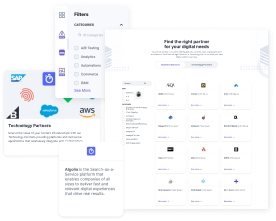What is a composable architecture?

Today’s consumers expect to interact with your business on any channel they choose, whenever they choose, and to stay ahead of the competition you need to be able to deliver seamless customer experiences across those channels. The need to quickly deliver new experiences and adapt to market changes has led more and more businesses to move toward a digital experience platform with a composable architecture. According to Gartner, “By 2023, organizations that have adopted an intelligent composable approach will outpace the competition by 80% in the speed of new feature implementation.”
What is a composable architecture?
In a traditional website or application, the front-end code (what the user sees and interacts with) is tightly coupled with the back-end code (the database and server-side logic). This can make development and deployment difficult as even small changes to the front end can require developers to make significant changes to the back end.
A composable architecture decouples the front-end and back-end code, making development faster and easier. A composable architecture typically uses a headless CMS, which provides an application programming interface (API) that the front-end code can call to fetch data. This separation of concerns means that the front end and back end can be developed independently, making deployments simpler and more efficient.
The benefits of a composable architecture
There are many benefits of a composable architecture, but perhaps the most important is that it allows for a more modular and scalable approach to website development. With composable architecture, individual components can be developed independently and then brought together to create a complete website or application.
This modular approach makes it much easier to scale a website or application as needed, since new functionality can simply be added as needed without having to re-architect the entire site. Composable architecture also tends to be more resilient than monolithic architectures because individual components can be swapped out or updated without affecting the rest of the system.
Finally, a composable architecture is often more cost-effective than monolithic architectures, since it requires less development time and effort to create and maintain.
Composable Architecture vs. Monolithic
In a composable architecture, also known as a microservices architecture, applications are built as a set of small, independent services that can be combined to form a complete app. This approach contrasts with the more traditional monolithic style of development, in which an app is built as a single, self-contained unit.
There are several advantages to composable architectures:
- They allow for greater flexibility and agility during development, as services can be added or removed without affecting the rest of the app.
- Composable architectures make it easier to scale apps, as services can be deployed independently depending on need.
- Composable architectures help prevent downtime, as failures in one service are isolated from the rest of the app.
Headless CMSes are well suited to composable architectures. In a headless CMS, the decoupled front end and back end allow content to be reused across multiple channels and devices without having to rebuild the entire app. As a result, headless CMSes give developers greater control over how content is presented and make it easier to create seamless user experiences across channels.

How to get started with a composable architecture
If you're interested in a composable architecture, the first step is to implement a composable digital experience platform with a headless CMS. A headless CMS provides the structure and content for your website or application but doesn't dictate how it should look. This allows you to build composable architecture that can be easily adapted and customized as your needs change.
Once you've chosen a headless CMS, you can start adding the different components that will make up your website or application. These can be anything from simple text and images to complex interactive elements. The key is to start with the basic building blocks and then add on from there.
As you add more components, you'll be able to create a truly unique and custom composable architecture that meets your specific needs.
To install composable architecture you will need to follow these steps:
Understand the ecosystem - audit the existing architecture and its capabilities
Assess the need for composability - scope out the requirements of upgrading to composable
Architect the requirements - based on business requirements, design the architecture that is required to achieve measurable goals for the business
Build the system - build, test, measure results and continue to evaluate and grow
Examples of composable architectures in the real world
Composable architectures are becoming increasingly popular in the world of software development. A composable architecture is one in which different parts of the system can be composed together to form a whole. This approach has many benefits, including improved modularity, flexibility and reusability.
One real-world example of a composable architecture is the microservices approach to software development. In this approach, different parts of the system are designed as independent services that can be deployed and scaled independently. This makes it much easier to update and maintain the system and allows greater flexibility in how different services are combined.
Another example of a composable architecture is the use of containers in modern software development. Containers allow different parts of the system to be isolated from each other, making it easier to deploy and run them on a different infrastructure. This approach also allows great flexibility in how different containers are composed together.
The future of composable architecture
The future of composable architecture looks very exciting. With the rise of the headless CMS, we are seeing a lot more flexibility and control over how we build applications. Now we can break down our applications into smaller, more manageable pieces that can be easily reused and composed into new applications. This gives us a lot more power and flexibility to build the applications we want without being tied to a specific platform or framework.
Composable architecture also allows us to easily change and adapt our applications as our needs change. We can simply add or remove components as needed, without having to rebuild our entire application from scratch. This makes it much easier to keep our applications up-to-date and responsive to our changing needs.
Composable architecture is a powerful tool that offers a lot of flexibility and control over how we build our applications. This makes it an essential tool for any business that wants to stay ahead of the curve.
Learn more
Learn about composable DXPs in our guide, “The ultimate marketer’s guide to composable DXPs.”Schedule a free demo to experience Contentstack and see how a composable architecture can propel your marketing strategy.
Related Articles
Here are other CMS articles we think you'll find useful.






9cb7.jpeg?format=pjpg&auto=webp)

